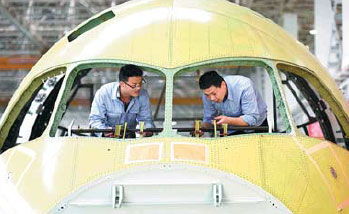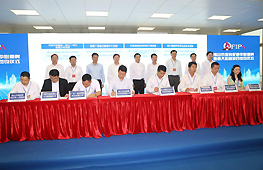Sichuan plays a role in first Chinese airliner C919
National strategy creates new competition for Airbus, Boeing duopoly, Huang Zhiling reports.
China's homegrown large passenger plane, the C919, had its maiden flight on May 5 in Shanghai.
After 79 minutes of flying, the twin-engine C919 landed safely at the Shanghai Pudong International Airport at 3:20 pm, signaling China's entry into the global aviation market.
In 2007, the State Council, China's central government, approved plans to develop a Chinese-built large passenger jet. Eight years later, the first C919 jet rolled off the assembly line.
The "C" in the aircraft's name stands for both China and Commercial Aircraft Corp of China (COMAC). The number 9 symbolizes "forever" in Chinese and 19 represents its 190 seats at maximum capacity.

With a standard range of 4,075 kilometers and maximum range of 5,555 kilometers, the narrow-body jet is comparable with updated Airbus 320 and Boeing's new-generation 737 planes, according to American aviation experts.
Made by the COMAC, the C919 is hailed as a notable achievement in the development of China's civil aviation industry.
Brian Foley, president of a New Jersey-based aviation consultancy in the United States, said that the C919 could compete with the current Boeing and Airbus duopoly, particularly if it became the preferred airliner of Chinese domestic airlines.
Sichuan-made parts
Many parts of the C919 are made in Southwest China's Sichuan province, including its nose, avionics system, recreation equipment in its cabin, interior lighting and radio, according to the Sichuan provincial government information office.
Located in the Sichuan provincial capital of Chengdu, CETC Avionics was set up by China Electronics Technology Group (CETC) with an investment of 1 billion yuan ($145 million) in 2009 to make the communication and navigation, data chain, cabin core, airborne entertainment and information systems.
The communication and navigation system is at the core of the plane's avionics, taking charge of the airground conversation during take-off and landing, as well as voice and data communication inside the plane and radio navigation.
According to Liu Tianhua, an engineer of CETC Avionics, the C919 is not the first domestically made big plane project involving the company.
CETC Avionics made the communication and navigation system for the AG600, which is China's first large amphibious aircraft.
The AG600, the largest amphibious aircraft in the world, will have its maiden flight in the first half of this year, according to the Sichuan provincial government's information office.
Sichuan Jiuzhou Electric Group in Mianyang, the second-largest city in Sichuan, is also involved in the C919.
It is the first time that Sichuan Jiuzhou Electric Group has participated in the development of a large plane, as it made the cabin core system.
According to Li Yixun, a staff member of the research group from Sichuan Jiuzhou Electric, the cabin core system consists of passenger broadcasting, cabin interphone and self-inspection.
Sichuan Jiuzhou Electric also made the lighting equipment for the cabin of the C919. The main lighting equipment is the so-called LED wall washer, which gives off a light that resembles water gently washing the surface of a wall.
The nose of the C919 is made by AVIC (the Aviation Industry Corporation of China) Chengfei Commercial Aircraft.
According to Chen Yong, a senior technician at AVIC, the noses of both the ARJ21, which is China's self-designed regional jet liner, and the AG600, are made by the company.
Military-civil integration
All the above-mentioned companies are in the military industry and engaged in the manufacturing of products for civilian use.
Sichuan has many military companies with a competitive technological edge.
The Chinese government has included the integration of military and civil industries in its national strategy.
At a panel discussion with lawmakers from Sichuan during the annual session of the National People's Congress in Beijing in early March, President Xi Jinping called for the acceleration of the integration of military and civil industries, adding that a high-tech industry base should be built for military-civil integration.
Sichuan is one of China's first eight experimental zones for all-round innovation and reform, and is home to the country's first zone making use of deep integration of military and civil industries to push forward all-round innovation and reform.
According to Chen Xinyou, head of the Sichuan Provincial Economic and Information Commission, the output value of Sichuan's military-civil integration sector surpassed 280 billion yuan in 2016, up nearly 8 percent over the previous year.
Sichuan has signed agreements with 12 military group companies under the central government to make use of their technological knowhow to serve the civil sector, he said.
In August 2016, a program related to the accelerated implementation of military-civil integration was announced in Sichuan. The province aims to nurture 10 big companies over the next five years, each with an annual output value of more than 10 billion yuan, Chen said.
Contact the writer at huangzhiling@chinadaily.com.cn
|
The C919, China's homegrown large passenger plane, makes its maiden flight on May 5 from Shanghai Pudong International Airport. Yin Liqin / For China Daily |
|
Technicians at the AVIC Chengfei Commercial Aircraft in Chengdu assemble a windshield for the nose of the C919. Liu Kun / Xinhua |
(China Daily 05/23/2017 page12)























